Our Summer Cruise 2016
May 16 - 22 |
May 23 - 29 |
May 30 - Jun 5 |
Jun 6 - 12 |
Jun 13 - 19 |
Jun 20 - 26 |
Jun 27 - Jul 3 |
Jul 4 - 10 |
Jul 11 -17 |
Jul 18 - 24 |
Jul 25 - 31 |
Aug 1 - 7 |
Aug 8 - 14 |
Aug 15 -21 |
Aug 22 - 28 |
Aug 29 - Sep 4 |
Sep 5 - 11 |
Sep 12 - 18 |
Sep 19 - 25 |
Monday, August 1
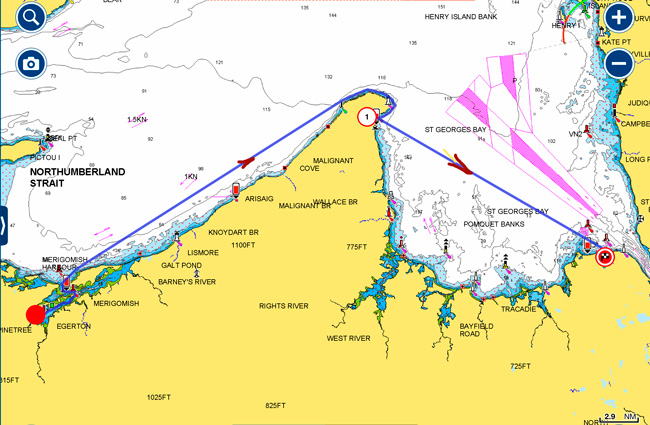
Merigomish, NS, to Havre Boucher (via Ballentyne's Cove) - 52nm
Was awakened from my beauty sleep this morning by a cry of "Come and look at the sunrise." Wiping the sleep from my eyes, I staggered up to the salon and it was quite spectacular, probably even better 20 minutes earlier when the sun was lower and the fog a bit thicker.
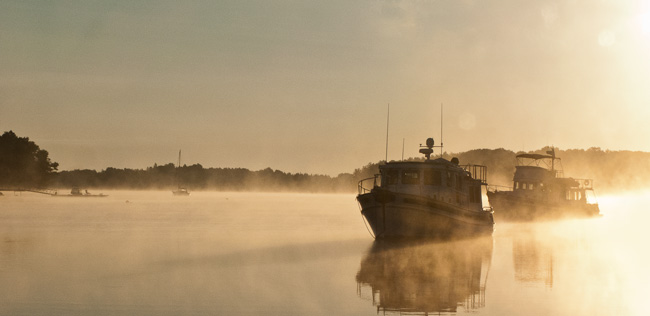
Retracing our route from yesterday, we entered the bay at Merigomish Harbor and, after a short distance, set a waypoint for Cape George 28nm away, hit the "NAV" button and settled back for almost four hours for breakfast and to catch up on some reading. At least we have good weather and the scenery, as we parallel the shore, has some interest.

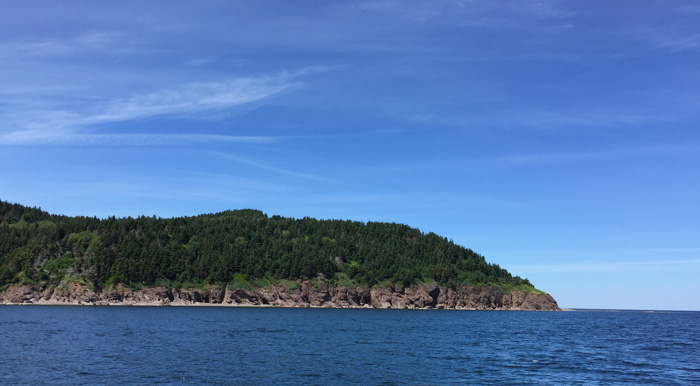
Cape George
Just around the corner from Cape George, we pulled into Ballantyne's Cove, a small fishing village, to go to the Bluefin Tuna Center. A tight spot to get into, Judy manoeuvered the boat well and tucked us into a corner behind two fishing boats. The docks were a little high and it was good to have the upper deck as it was just a small step up to the dock. We didn't have much depth and we churned up a lot of red mud as made our way in. Encore, which went further into the harbor, was on the bottom but the tide was rising!

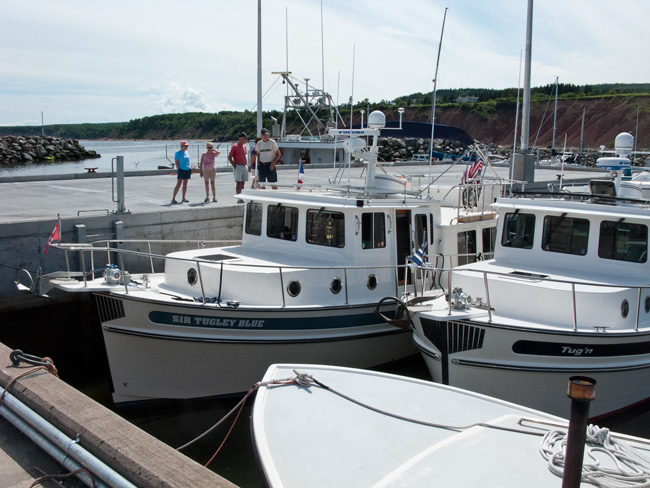
STB with Tug'n Rafted Up Against Us
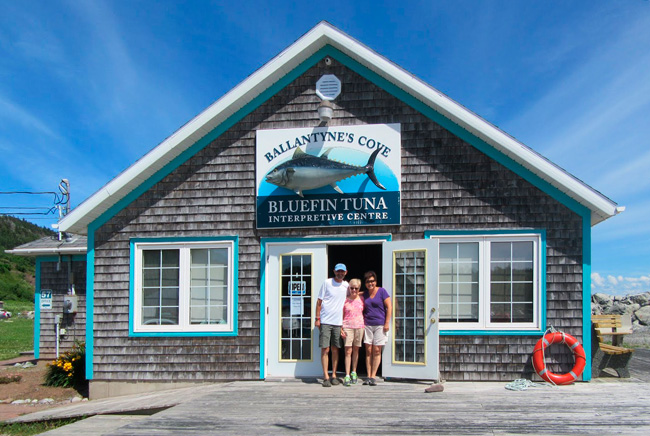
Bluefin Tuna Interpretive Center
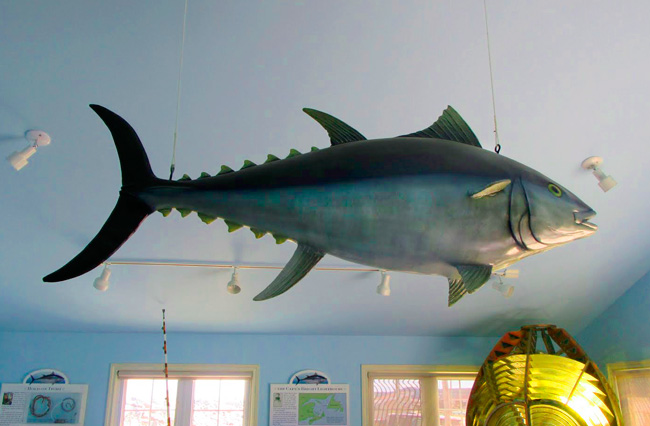
A Small 300 Pounder
Ballantyne's Cove is one of a series of centers for bluefin tuna fishing in the Northumberland Straits and Cape Breton. They have very restrictive fishing regulations for tuna governed by an International Commission. Canada is allocated 600 licenses split amongst Nova Scotia, New Brunswick, PEI, and Newfoundland with a combined weight quota of 450 tons. Tuna typically range from 500 to a record breaking 1496 pounder. Bluefin tuna caught while fishing for other species are taken out of the quota. Only rod and reel can be used to catch and land tuna and there have been some epic battles including a 62 hour marathon with six people involved to land a 900 lb. monster. A mature adult can travel at 50 mph and dive to a depth of 3000 feet.
The current price of a 30 year licence is about $30,000 however, it is very unlikely that one could buy one for this price since they are usually passed down in a family. There is a secondary market in licenses and $60,000 is the current asking price. They have devised a complex process for allocating the quota per license based on historical catch numbers but, essentially, the quota per license means most owners can catch one large tuna per season. The bluefin tuna season begins in the Spring and Runs through November but normally each fleet sets a time in late July or early August based on the migratory pattern for the season; later is better since a tuna can grow up to 4 pounds a day.
A top quality tuna will sell for up to $140 per pound on the Japanese market where most of the bluefin tuna catch ends up being used for for sushi and sashimi. If you are lucky enough to get one of the first Atlantic Bluefins of the year, it could sell for $3,600 a year as competition is tremendous in Japan to have the first of the year. Needless to say, the fisherman only gets a fraction of that, usually $12-20 a pound depending upon quality.
Our guide for the tour was a young woman who is going to take over her father's lobster fishing license in a few years; only about $350,000 on the open market. If she becomes as knowledgeable about lobsters as she is about tuna, she will do well!
Back out in the Strait again, we continued on to Havre Boucher and, as promised, all of the waves funnelled down the bay to the Canso; waves built from both directions and were very uncomfortable with pitching and rolling for the last hour. Before they picked up too badly, Tug'n and STB cranked the rpm up for an 80% run for ten minutes or so to exercise the Cummins; it seemed much smoother.

Tug'n at 13 kts
Another very quiet day for traffic, almost like being on Lake Michigan; just one rusty old trawler dragging its nets.
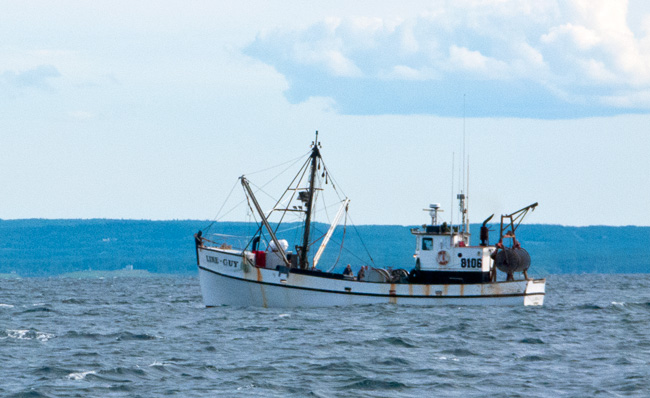
Havre Boucher turned out to be not quite as protected as advertised with relatively flat land around and a good breeze. Hearing "slapping" in our brains, we decided to tie up at the government wharf at the small village of about 1500. I think the word must have got out that there were three Nordic Tugs (and an American Tug) in town because there was a lot of cars cruising down on to the dock all evening and a number of people stopped by to chat.
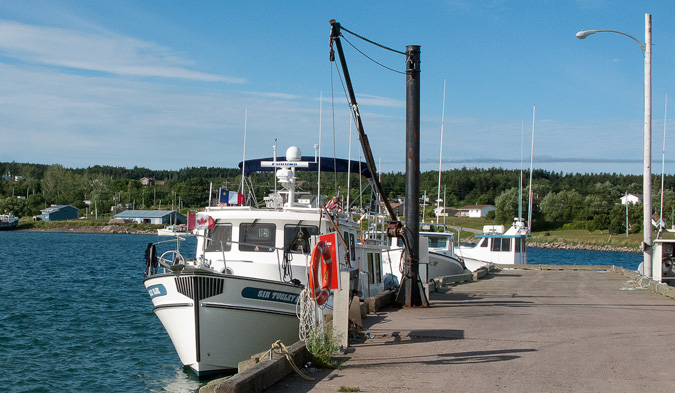
Havre Boucher has been lucky enough to be allocated significant funds to establish a new Small Harbor and construction was well underway, with concrete pilings and a main dock set.
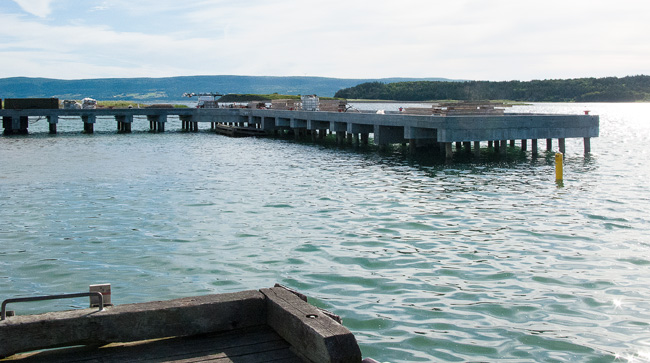
Dredging is ongoing with truck after truck being being loaded by a huge excavator. Eventually, they will have fixed and floating docks with power and water and a cafeteria to attract more fishing and recreation boats. Everywhere we have been in Canada, infrastructure projects seem to have a high priority; send some our way - on second thoughts, don't worry, "the construction foreman said "the Donald" is going fix all of your roads, bridges, and walls!"
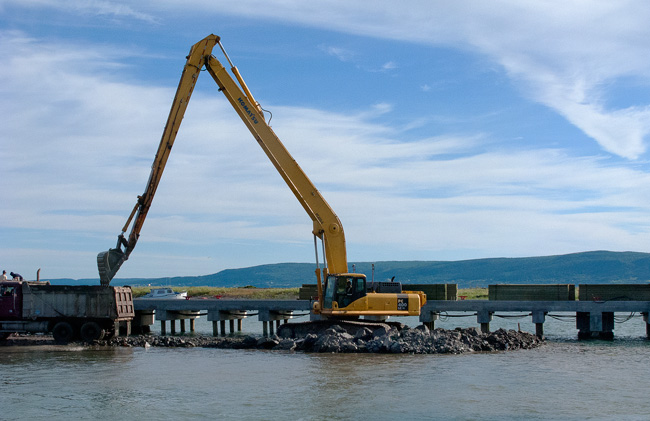
Tuesday, August 2

Havre Boucher to Haddock Harbor - 23nm
Not too early a start and a warm sunny morning. No-one we talked to last night seemed to have any idea who to pay for the overnight dockage of $10 (with 15A power as well); the most common answer was if someone shows up pay them, if not don't worry.
Half an hour later, we were in the Strait of Canso heading for another lock. The Strait is a long thin channel approximately 18 miles long and averages 2 miles wide (3/4 mile at its narrowest) connecting Chedabucto Bay on the Atlantic Ocean to St. George's Bay on the Northumberland Strait. Before the Causeway was built, the tidal current was a major problem for shipping; tidal current could be as high as 7 kts making it dangerous for large ships. The alternative was to go around Cape Breton Island, a significant increase in mileage and cost. It was decided in the early 1950s to build a long rock causeway (ten million tons) to almost completely block the channel and add a lock to control flow from one side to the other. The Causeway was completed in 1955 and had the added benefits of linking Cape Breton Island with the mainland via a bridge over the lock (previously it was a car ferry ride) and creating one of the deepest ports on the east coast - Port Tupper, that can accommodate the largest supertankers.
Claims have been made that the Causeway had an impact on the herring fishery and the lobster industry and introduced some non-native species to Cape Breton, such as the cougar. No scientific date seems to support the reduction in the herring/lobster catches which were already in decline. The best lobster catch was actually the year the Causeway was completed. Whether the Causeway provided a path for cougars is debatable - no evidence has been found of Eastern Cougars in Nova Scotia and no confirmed sightings have occurred on Cape Breton.
The lock is the size of those on the St. Lawrence Seaway permitting the largest seagoing vessels but for us, we just floated in the middle for a few minutes as the tidal difference between the two sides was equalized.
.
Encore and Tug'n Exiting the Canso Lock
Awaiting our passage on the other side was the worst looking ship to date - when he put it in gear, he emitted a huge cloud of black smoke - this boy needs an engine overhaul and a good coat of paint!

Atlantic Enterprise - NY, New York Going to Montreal - If It Makes It

The Heavily Industrialized North Shore - Looks Like Montreal
Not wanting to make too long a day of it to allow Bob and Jan to catch up some, we decided to anchor for the night at Haddock Harbor (or Bay as we would call it) on the south side of the Lennox Passage that eventually leads to Chedabucto Bay. The anchorage is really part of Ile Madame which was French as part of its colony of Île-Royale (present-day Cape Breton Island). After the fall of Louisbourg (see later) in 1758, all 4,000 inhabitants were deported. However, a group of ten Acadian families from Port-Toulouse fled to Ile-Madame where their descendants still live today. Following the Seven Years' War between France and England, Île-Royale and its constituent territories such as Ile Madame, reverted to British control. Some Acadian families also made their way back from Massachusetts to Isle Madame in 1766 after being deported.
We tried the area on the chart that looked the best for the predicted wind but it was flat all around; i.e., open to any wind. We backtracked a little and found a suitable spot close to shore. Haddock Harbor is not very scenic and would not be on our recommended list. Inhabitants Bay on the north shore of the Passage may be a better location.
Haddock did redeem itself somewhat later in the evening with a decent sunset and great magenta reflections to the east behind Tug'n and Encore and a streaky sunset to the west.
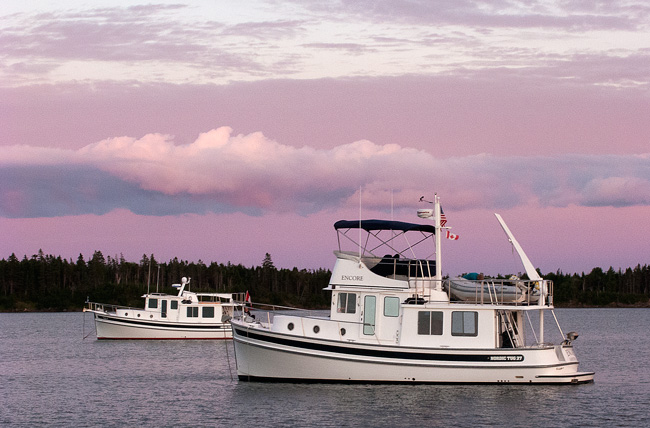
Wednesday, August 3
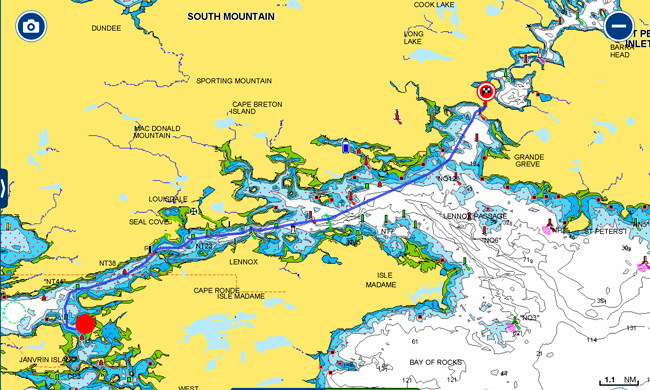
Haddock Harbor to St. Peters, CBI - 16nm
Bob and Jan had a good day on the water and made it all the way to Ballantyne's Cove so they should catch up with us today or tomorrow. Stephen and Fran planned to stay at Haddock Harbor until later in the day, head for the St. Peters Lock, and tie up there to meet Bob and Jan on Thursday. Encore and STB left early to get to St. Peters - just a short run of a couple of hours through the Burnt Island Bridge and into the St. Peters Lock where we were met by a very friendly crew from Parks Canada which operates the lock.
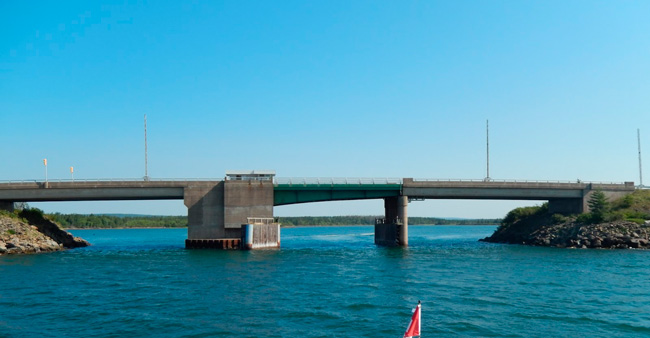
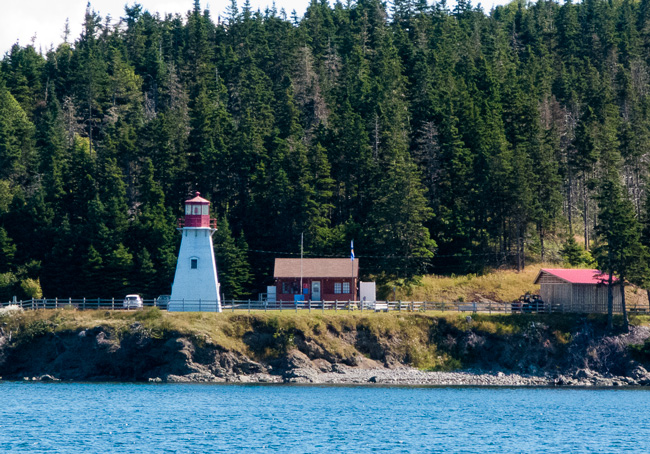
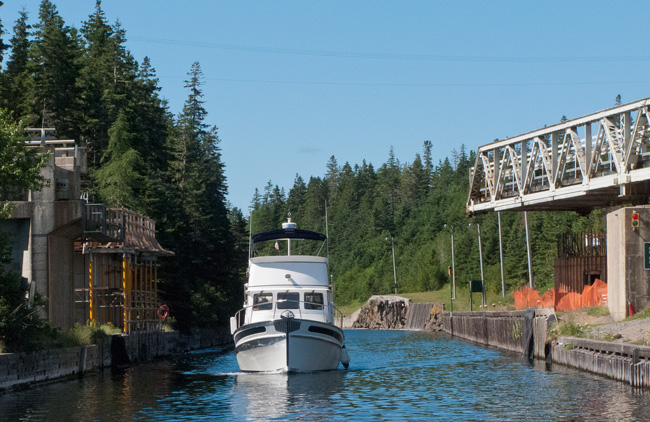
Encore Exiting the St. Peters Lock and Bridge
In twenty minutes, we were greeted by the staff of the Marina (run by the local Lions Club) and safely tied up. The rest of the day was taken up with grocery shopping, laundry, boat cleaning, trips to the hardware store and the German bakery near the marina, and getting Judy a hair appointment. The bakery had an interesting humorous sign....

We also spent a couple of hours getting the intelligence on the Bras D'Or Lakes and places of interest. We had already reserved cars for pick-up on Friday for a couple of days so we wanted to make the best use of them. While Googling around, I came across a site - www.cruising-cape-breton.info that has an excellent cruising guide for the Lakes with just about every marina and harbor you could ever need. Each is well described and includes detailed charts with far more detail than our chart plotters. It is kept up to date much like the Great Lakes Cruising Club harbor reports; but free - it would prove to be invaluable.
Later in the day Tug'n showed up at the Marina; they were unable to tie up on the lock wall as planned so they got a nice slip, overshadowed by a 68' Nordhavn docked in front of them.
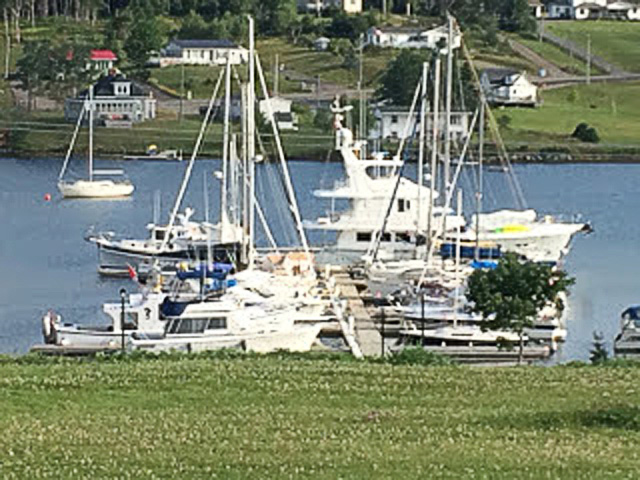
Tug'n Being Dwarfed by the 68' Nordhavn
It turned out that the owner was the biggest lobster wholesaler in Nova Scotia. We also ran into Roland and his wife from New Zealand who had been cruising for the past 15 years around the world, much of the time on a lovely 52' Sparkman and Stevens pilothouse ketch, and spent a good amount of time talking about our trip and his.

The Tourist Photo at the Marina
Thursday, August 4
Happy Birthday to me! Thank you to all who sent me cards in advance, gave me cards today, or sent greetings via Facebook.... do not feel a year older! Just because it was my birthday, I didn't get the day off and did some more boat cleaning and odd jobs.
Bob and Jan arrived this morning, so all four of the boats are back together again. Lee from Encore spent three hours with us going through our Maptech Chart Book marking up the best anchorages in Maine, Massachusetts, Connecticut and Rhode Island .... we must have sixty anchorages for next year lined up. Plans for the coming week or so were laid out and discussed at length with a number of nearby boaters who frequent the area and we came up with a shortlist of those places that were highly recommended.
STB hosted the happy hour this evening breaking out the bimini for only the second time this year as it was quite hot today. Later in the evening, the crews of Tug'n, Wings, and Encore joined us up top of STB again for the Thursday night concert being held on the grassy slope in front of the marina - balcony seats! Variety of music but the highlight was some Gaelic music with a mother and her very young daughter step dancing like there was no tomorrow.
To celebrate my birthday, the Lions Club had a seafood chowder for the community and they excelled themselves with big chunks of seafood in a great tasting sauce. We had our own small celebration in the Marina clubhouse with the chowder followed by prosecco and a German cheesecake. Unfortunately no one had their camera so I'm not sure the birthday really counts; maybe I'm still 65?
Friday, August 5
The weather was forecast to be unsettled over the next few days which worked well for our plans to see some of Cape Breton by car so we made the final arrangements to pick up rental cars that were being transported back from Halifax later in the day. More conversation on anchorages today with a wide variety of "favorite anchorage" being given to us. Judy got her haircut managing to get a cancellation at the last minute ... $25 with tip and eyebrow waxing! You can't beat that price..... Worked on the blog.
National came through later in the afternoon with our cars and Gerry, the Marina Manager, was kind enough to run us to Port Hawkesbury, 35 miles away, to collect the cars; matching Toyota Corollas.
Later in the evening at dusk, RH3, a 122' expedition yacht by RMK Marine came in and anchored in the Bay. It had its own chase boat, a 45' rigid hull inflatable with twin inboards. Cape Breton seems to see its share of large yachts.
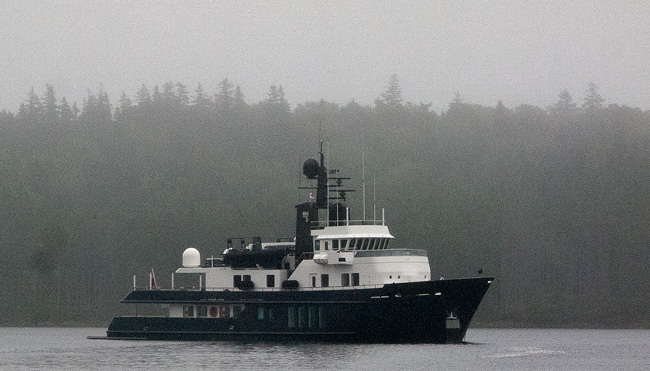
RH3 in the Fog
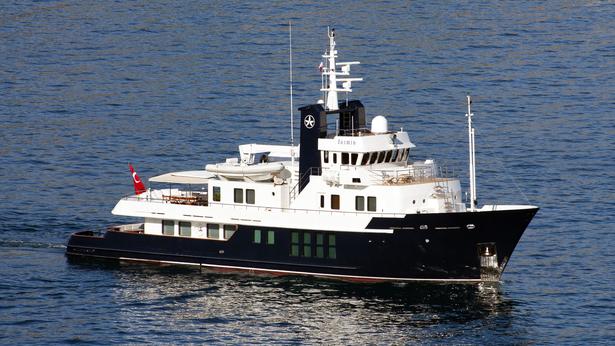
RH3 in Sun
Every Friday night throughout the summer, the marina hosts a Ceilidh from around 7:30 to 10:00pm in the clubhouse. A Ceilidh is a traditional Gaelic social gathering, which usually involves playing Gaelic folk music and dancing. It originated in Scotland and Ireland and is consequently common in the areas with Scottish and Irish heritage such as Cape Breton Island. This one had no dancing but made up for it with about twelve musicians; keyboard, guitarists, fiddler, drummer, percussionist, spoons, clarinet, and a couple of flutes and whistles. It was very informal with players coming and going throughout the evening with each leading a song or tune around the circle of musicians.
Most are just amateurs but a few were very talented. All the chairs were taken by 8:00 pm and the audience enjoyed a great evening of song and music.
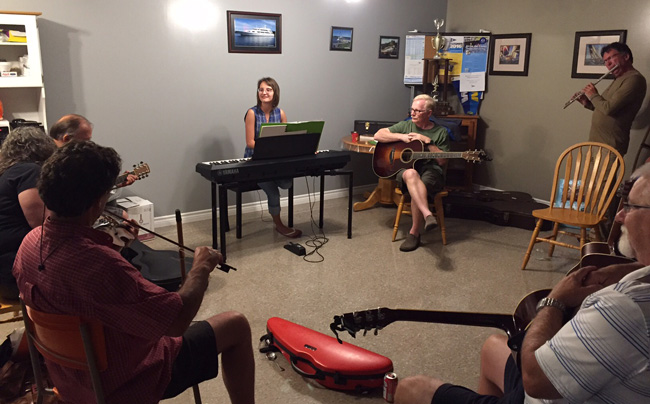
Saturday, August 6
Had an early start for our driving tour of the Island with Steven and Fran. Today we were going to drive the scenic Cabot Trail around the west and northern parts of Cape Breton.
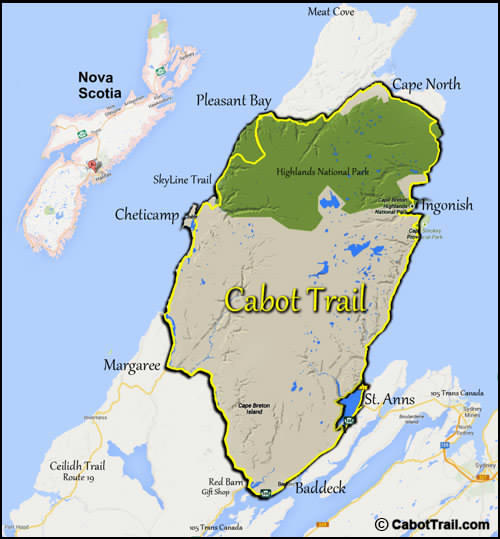
The Cabot Trail makes a 185-mile loop around a sizeable chunk of the island, passing through the Cape Breton Highlands National Park at its northernmost point. A 367-square-mile flat-topped plateau cut by deep river valleys, this wilderness is home to moose, black bears, and bald eagles. Mostly, the Cabot Trail skirts the edges of the park, at times clinging to steep ocean side cliffs. We chose to drive the Trail counterclockwise to maximize the views along the way. From the Marina we had about a 60 mile drive to reach the start of the Trail and we were hoping we might be able to find some overnight accommodation in or around Baddeck as we would be driving there again tomorrow.
Some of the scenery along the Trail......
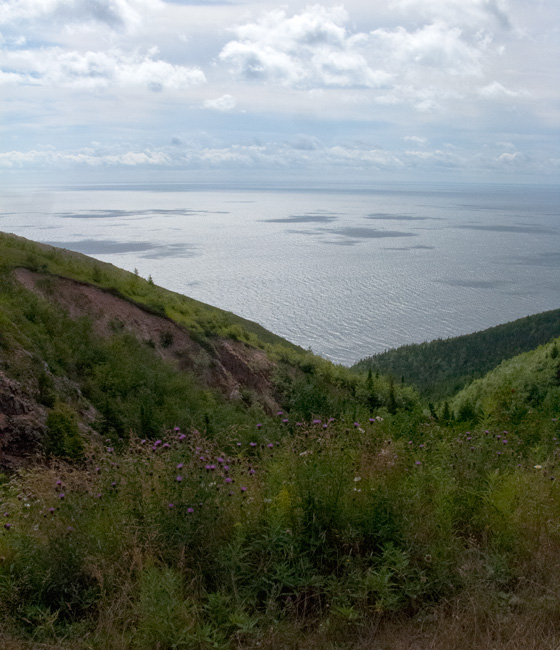
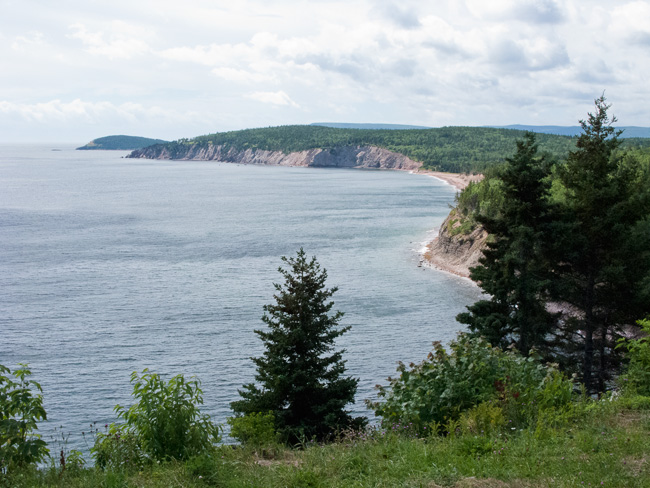
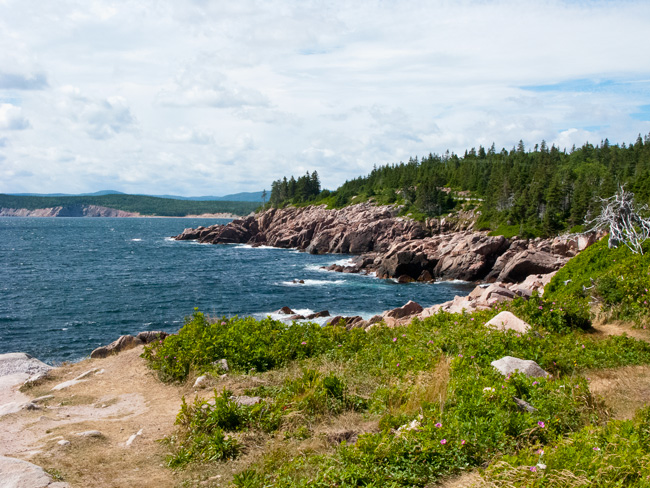
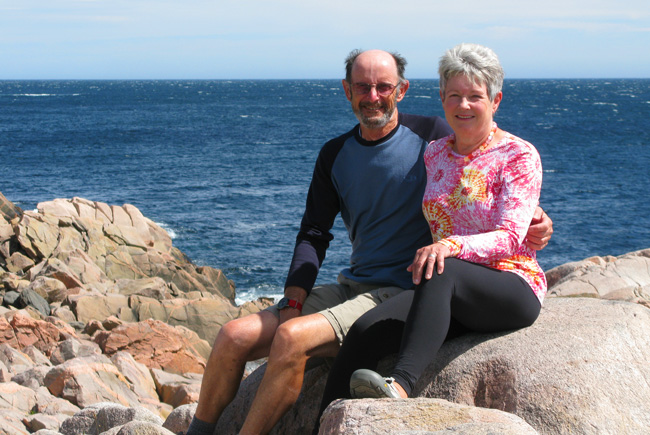
Windy Day and Needing A Haircut!
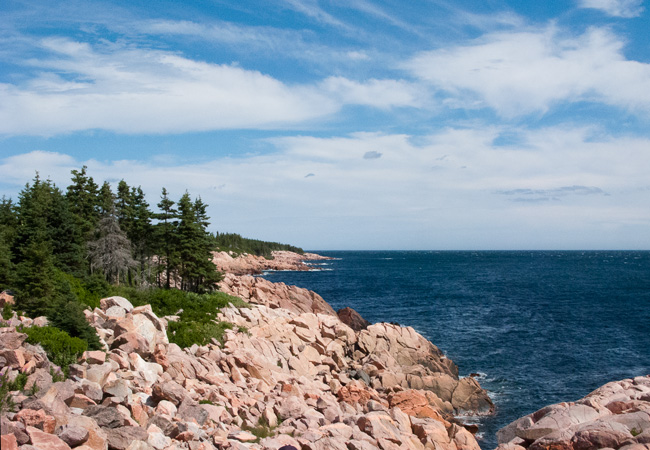
Just before the northernmost point of the trail we took a side road to the northeast to Dingwall, the closest we would get to Newfoundland and a popular departure point for boats travelling to Point Aux Basques on the Island. Dingwall was once a somewhat booming industrial town in the early 20th century when it was home to the National Gypsum Company Quarries, the remnants of which can still be seen. The Dingwall quarry was in full production after World War II, but harsh winters and a shallow port limited production to the months of May through November and harbor silting was a continual challenge. The quarry closed in 1955 and many left the village so that it population is less than 600 today with fishing and tourism being the main occupations.
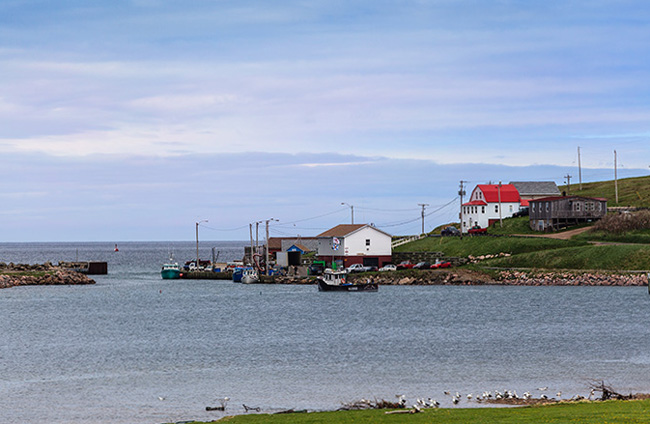
Dingwall Harbor
Dingwall is home to the St. Paul's Island Museum. The uninhabited island lies about 15 miles northwest of Cape North and 44 miles southwest of Newfoundland in the Cabot Strait. Only three miles long and one mile at its widest, it is a solid block of granite almost 500' high with rugged cliffs on all shores. Situated where it is in the Cabot Strait and fogbound for much of the year, it posed a significant danger to ships before accurate navigation tools appeared. It is estimated that at least 350 ships were wrecked on the Island, one as late as 1954. It became known as the "Graveyard of the Gulf of St. Lawrence.
Many survivors made it to shore but perished on the barren island. In winter, it is said fires could be seen but there was no way to reach the survivors. One ship, the Jessie, was wrecked on New Year's Day in 1824 and all survived but were to die over the next ten weeks of starvation. Every Spring, when the weather was good enough, a party from Cape Breton would go to the Island to bury the dead. Eventually a lifesaving station was established and many lives were saved.
The first lighthouse was built in 1839 and burnt down in 1916, a common hazard it seems with lighthouses. It was replaced in 1917 with a cast iron lighthouse that was decommissioned in 1962 and moved to Dartmouth. Eventually, it was moved to Dingwall to the St. Paul's Island Museum where it is a centerpiece.
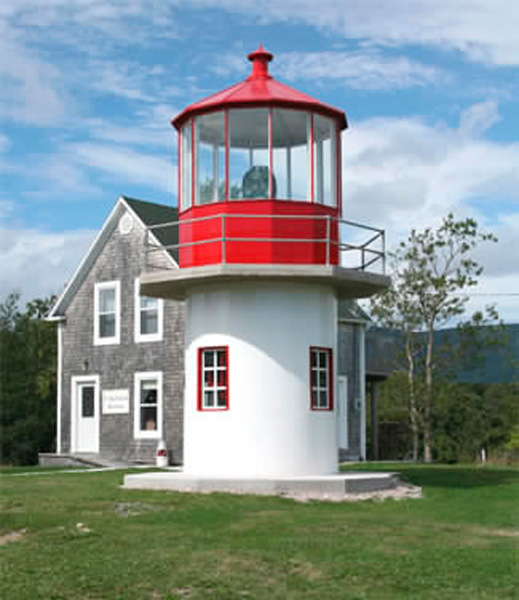
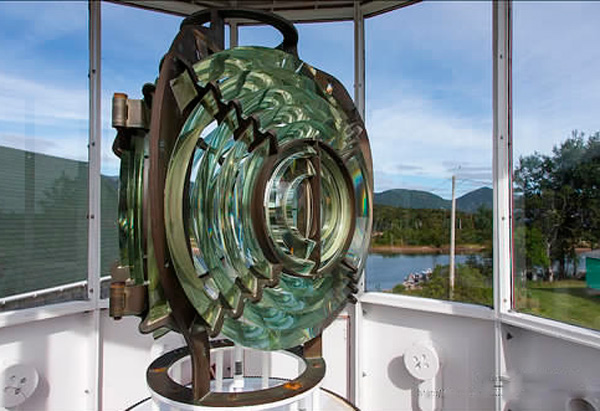
The Museum has a fascinating collection of artifacts and historical documents from the Island, many associated with the shipwrecks, and we were given a tour by a very knowledgeable guide who was only 15. The tour also included the restored lighthouse pictured outside the building. Well worth spending an hour or so there.
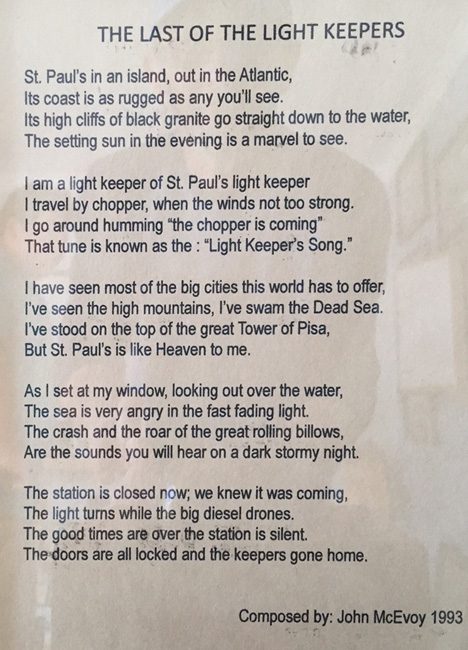
At the northernmost point of the Trail, we continued on a side road to Meat Cove at the tip of Cape Breton Island .... the last 10 kilometers were unpaved but in fair condition. The road winds back and forth with steep climbs and falls, luckily with good guard rails and we even saw a couple of intrepid bicycle riders making the trip! There is a decent size campsite and a small restaurant here perched on the top of the cliff that falls away to rocks below and a beach to the east. Some hardy souls, mostly children, were swimming in the 60 degree water!
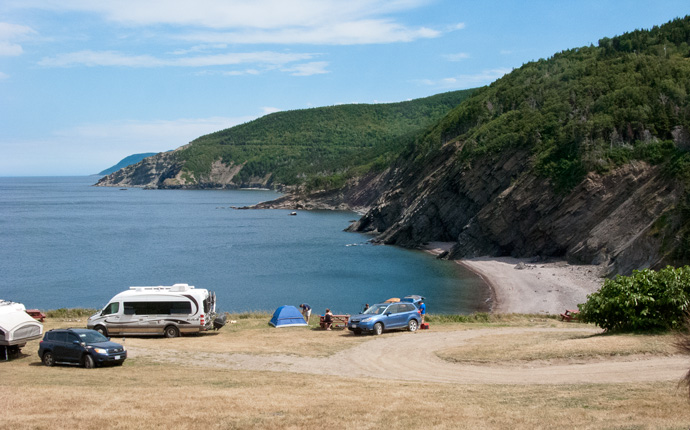
Meat Cove
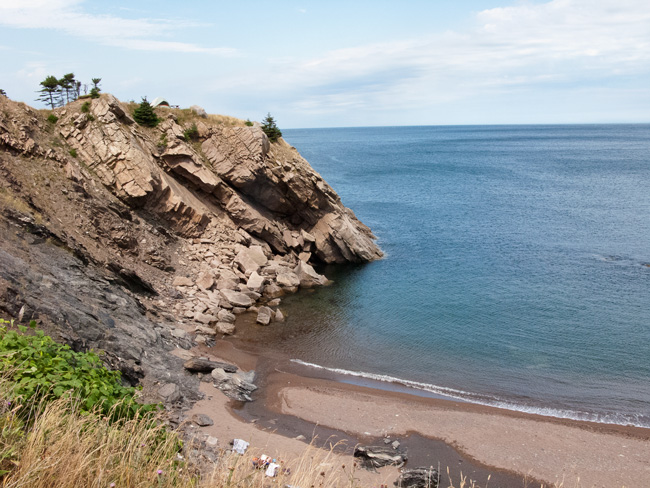
The Last Beach on CBI
From Meat Cove, we retraced our path back to the Cabot Trail and continued west across the Highland to Pleasant Bay with some stunning scenery such as the MacKenzie River Valley below. The Trail would be spectacular in the Fall colors, as there is a wide variety of deciduous trees here.
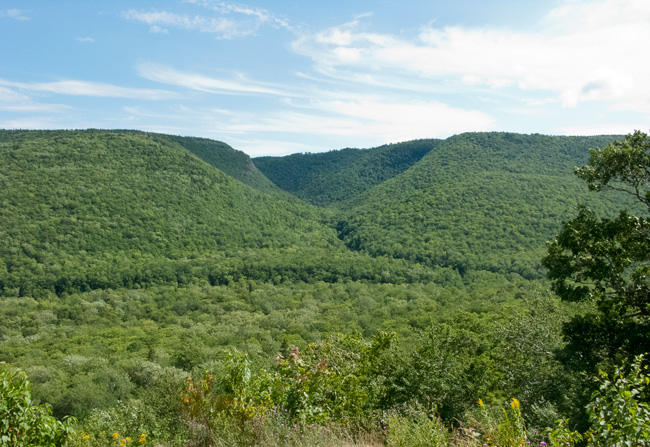
MacKenzie Mountain Valley - Clearly Plateau Country
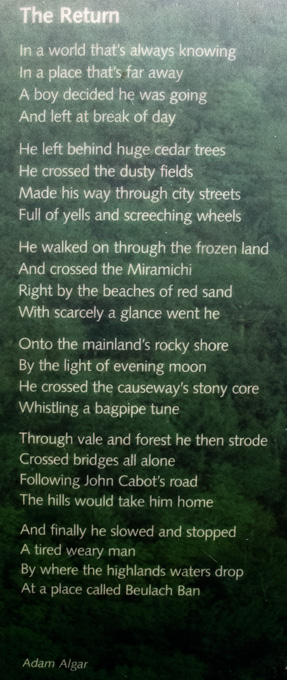
A Poem About the Trail
Our stomachs were rumbling by the time we arrived at Pleasant Bay and so we stopped at the Rusty Anchor that had been recommended by JP on the dock at St. Peters. Good seafood all round but have the haddock and fries versus the sole and fries.
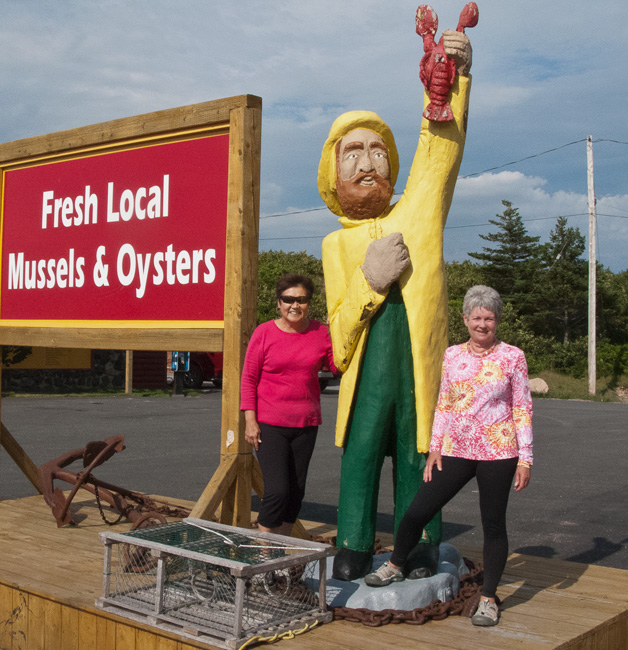
Another Tourist Photo Op!
Back on the road, we were now alongside the western shore of CBI heading south with sea views to right and the Park to the left.
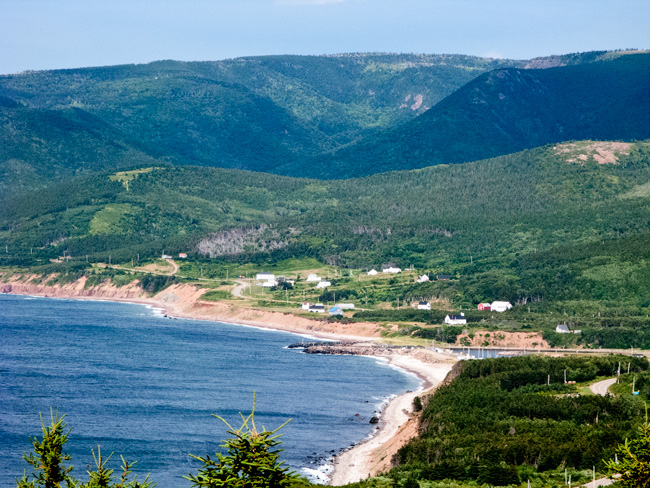
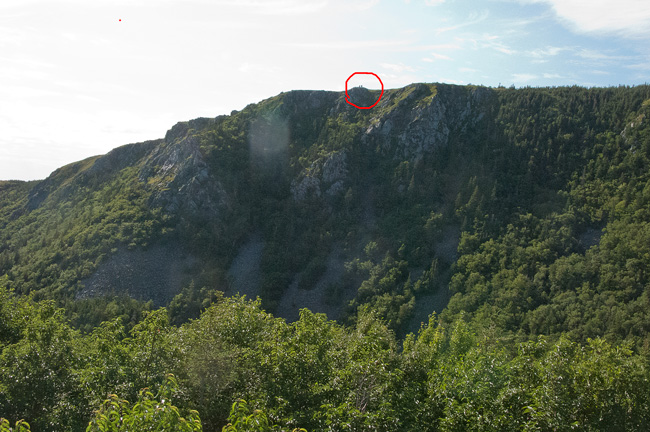
With more time, this ridge would have been a good hike out to a headland with excellent views. If you look closely, two people are circled in red. There are a number of short hikes to do around the Trail with a few longer ones and one really needs a few days to allow more time for sightseeing and a few walks.

Our Road Snaking Away Into The Distance
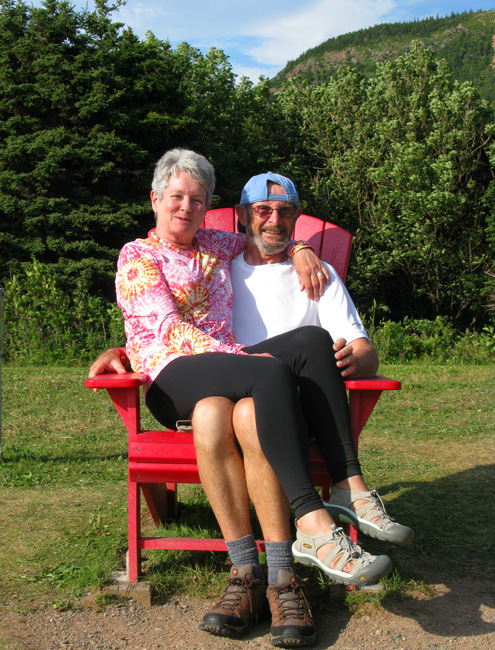
Sharing One of the Park's Two Red Chairs
Our journey continued down through Cheticamp, a fishing village at the western entrance to Cape Breton Highlands National Park and were surprised to see the Acadian flag everywhere. The community has almost 4,000 residents, a large majority of whom are Acadians and speak French natively. Together with its smaller neighbor, Saint-Joseph-du-Moine, Chéticamp makes up the largest Francophone enclave on Cape Breton Island and is considered one of the Acadian capitals of the world. In the years following the Great Expulsion, many Acadians came to this area. Today Chéticamp, which is at the entrance of the Cape Breton Highlands National Park, is a popular tourist spot.
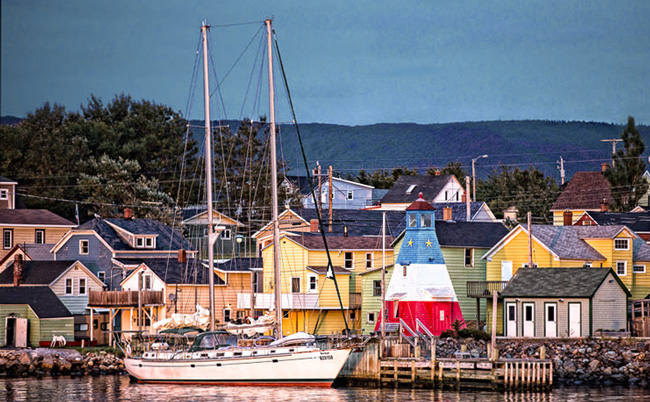
Cheticamp Waterfront
We had no success in finding any overnight accommodation so we continued south before the Trail headed into the Margaree Valley taking us southeast back to Baddeck and the long trek back to St. Peters, arriving at the boat at dusk. A very long day covering almost 400 km (250 miles), way beyond our daily allowance of 150 km; just as well we are sharing the cost as we have another long drive tomorrow.
Sunday, August 7
Slept well after yesterday's long trip but were at the car at 9:00am for the two hour drive northeast to Louisbourg via Sydney; an alternate route from going via Baddeck (not the most inspiring). The ride was actually quite scenic with frequent glimpses of the East Bay and a number of small harbors - almost all too small for us.
Loiusburg turned out to be a small village with a number of historic buildings, most catering to the tourist trade associated with Louisburg Fortress just a short distance further on.
The Fortress of Louisbourg is a National Historic Site of Canada and the location of a one-quarter partial reconstruction of an 18th-century French fortress administered by Parks Canada. We found out the difference between a fort and a fortress; a fort is strictly military, while a fortress is a fortified town.
The original settlement was made in 1713, and initially called Havre à l'Anglois. Subsequently, the fishing port grew to become a major commercial port and a strongly defended fortress. The fortifications eventually surrounded the town. The walls were constructed mainly between 1720 and 1740. By the mid-1740s, Louisbourg was one of the most extensive (and expensive) European fortifications constructed in North America. It was supported by two smaller garrisons on Île Royale located at present-day St. Peter's and Englishtown. The Fortress of Louisbourg suffered key military weaknesses, since it was erected on low-lying ground commanded by nearby hills and its design was directed mainly toward sea-based assaults, leaving the land-facing defences relatively weak. A third weakness was that it was a long way from France or Quebec, from which reinforcements might be sent.
It was captured by British colonists in 1745, and was a major bargaining chip in the negotiations leading to the 1748 treaty ending the War of the Austrian Succession. It was returned to the French in exchange for border towns in what is today Belgium. The French didn't learn their lesson; it was captured again in 1758 by British forces in the Seven Years' War, after which its fortifications were systematically destroyed by British engineers.
Its two sieges, especially that of 1758, were turning points in the Anglo-French struggle for what today is Canada.
The Fortress and town were partially reconstructed in the 1960s and 1970s, using some of the original stonework, primarily with a goal of alleviating unemployment in Cape Breton island due to the coal and gypsum mine closures.
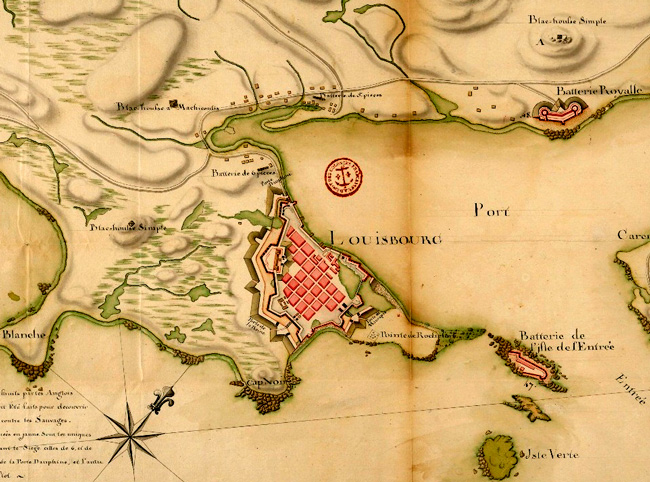
Original Map of the Fortress of Louisburg
We were greeted at the main Fortress Gate by:
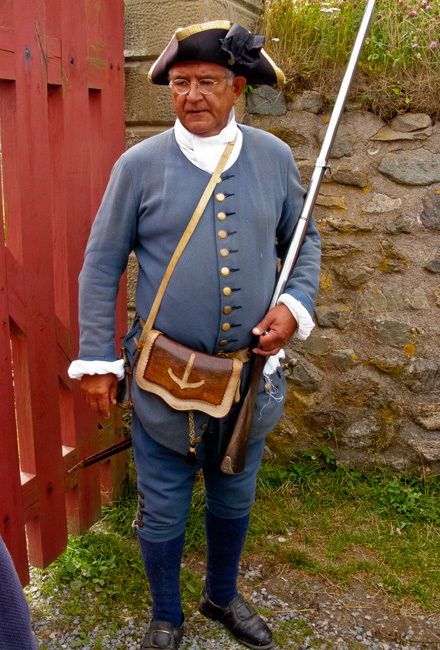
Monsieur Leblanc - the Sentry
and into the Fortress we proceeded across the moat which would have provided a good barrier to attack as they could trap the high tide within it using sluice gates.
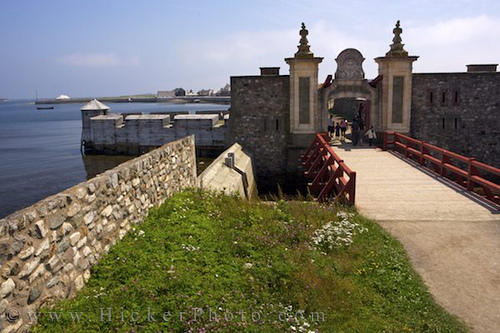
The Main Gate Gives One An In Idea of the Importance of the Fortress
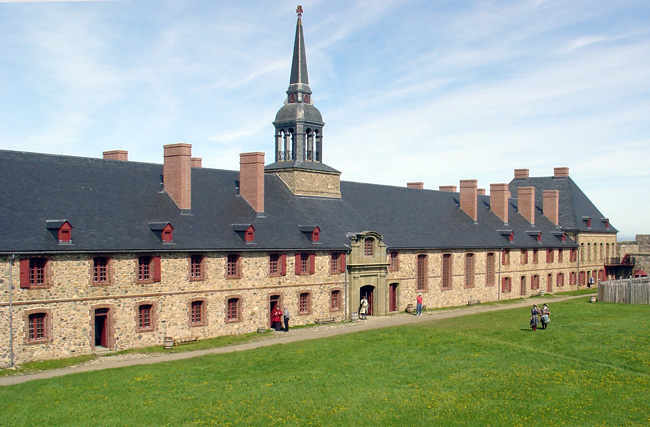
The Governor's Apartments and Barracks
As mentioned earlier, only approximately one quarter of the Fortress and the enclosed town has been rebuilt but the scale of the project must have been enormous as only the one main building above remained relatively intact. To rebuild the remainder entailed taking the original plans which were fortunately well maintained in France, years of research to determine plan variations, training hundreds of stonemasons, carpenters, roofers, blacksmiths, lockmakers, etc. in the traditional techniques used in the original construction, and painstaking archeological excavations of the site before re-construction could begin. Over a million artifacts were recovered to provide patterns for everything from nails to coat buttons for the rebuilding effort.

Aerial View To Give Idea of Scale
Today the site is "inhabited" by people, including children, dressed in period costume performing traditional skills such as blacksmithing, lacemaking, baking, etc. Unfortunately, most of the demonstrations are scheduled in the morning, so we missed a number of them but did have an excellent tour by one of the Parks Canada guides, from whom we learnt much of the history of the Fortress. We had been told that we should allow about 2-3 hours for the visit from people in St.Peters but, in retrospect, a full day was needed.
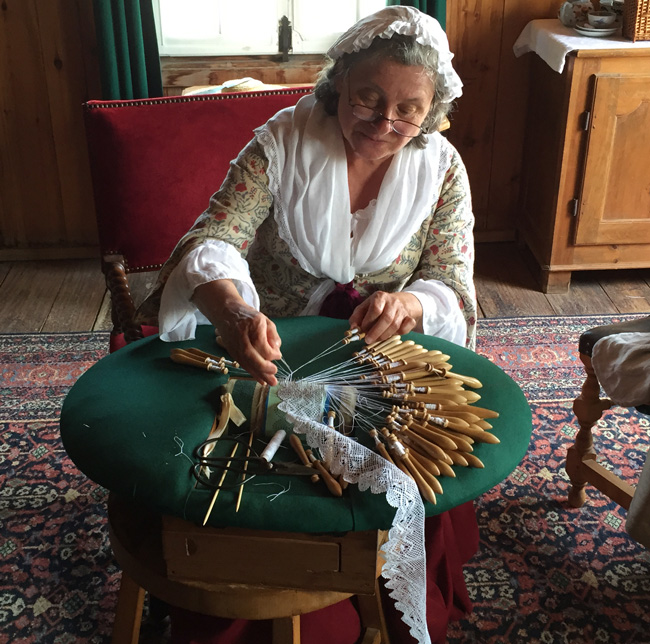
The Lacemaker
We did get to see a number of the military demonstrations including, musket firing....
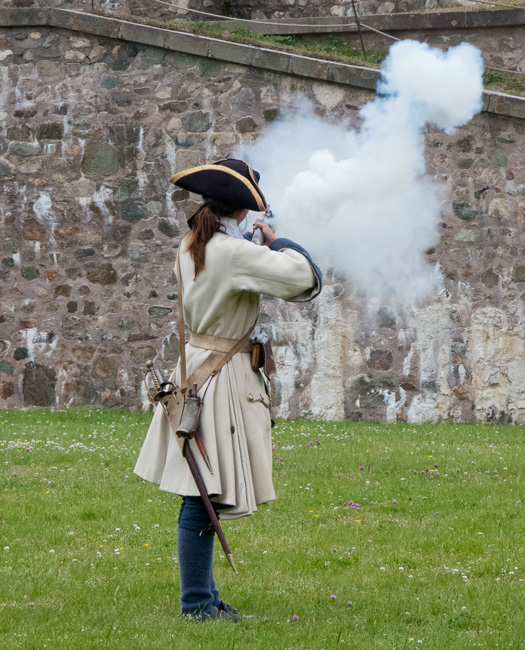
the fife and drum band .....
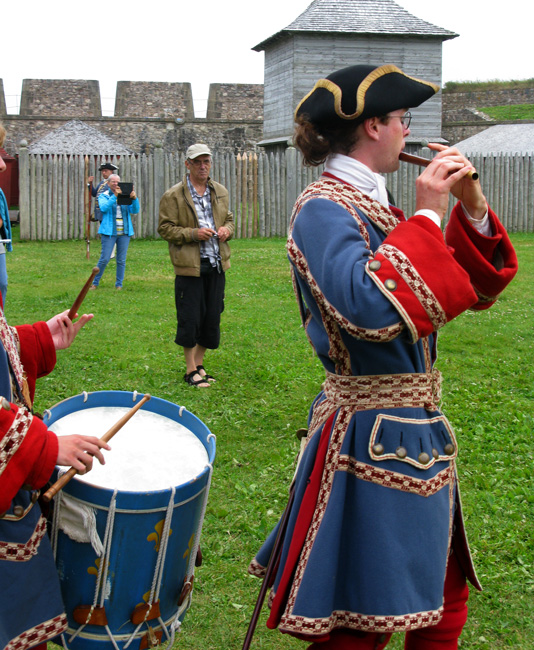
and cannon firing ....
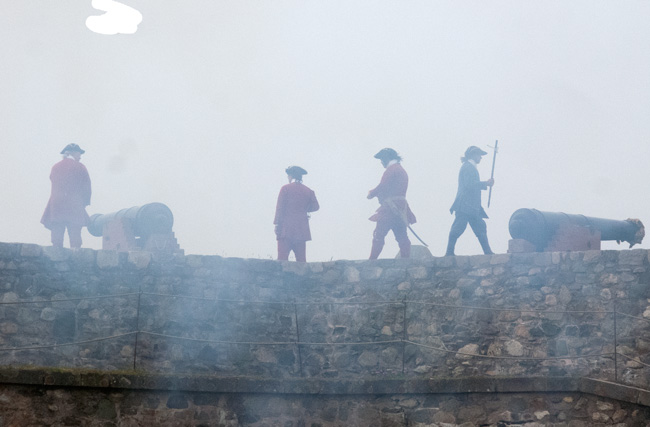
a typical soldier of the day ....
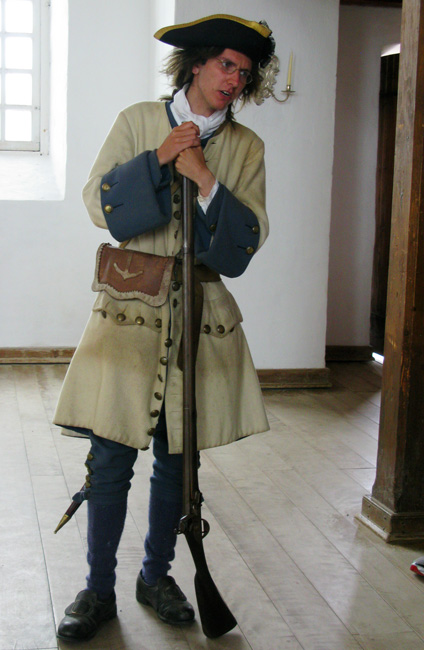
and went to the tavern .....
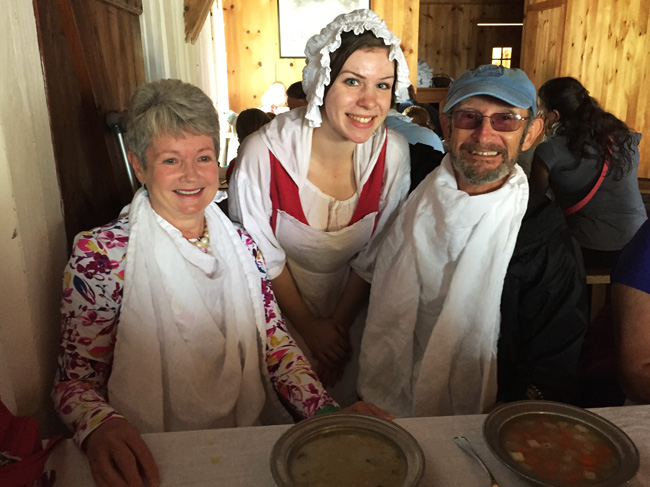
Traditional Seafood and Vegetable Soup Served by a Comely Wench

One of the Many Interiors With Period Furniture and Articles
One of the surprising things about the town portion of the Fotress was the variety of styles and construction of the many homes. Our guide explained that this was, in part, due to where the owner came from originally and also their status in the community. Just a few examples....
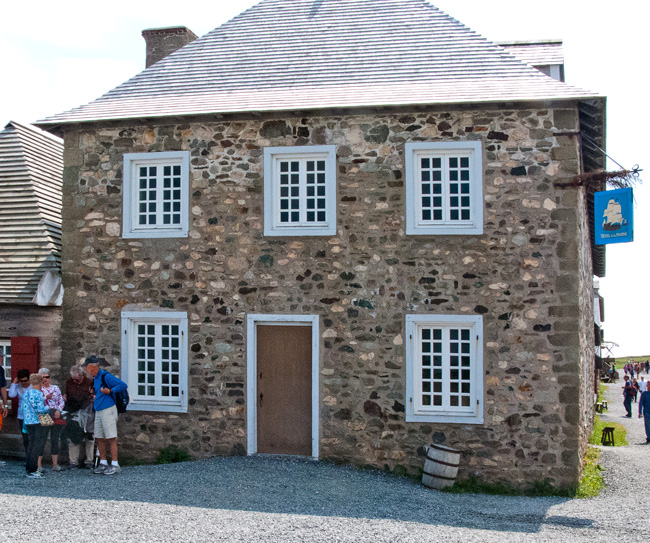
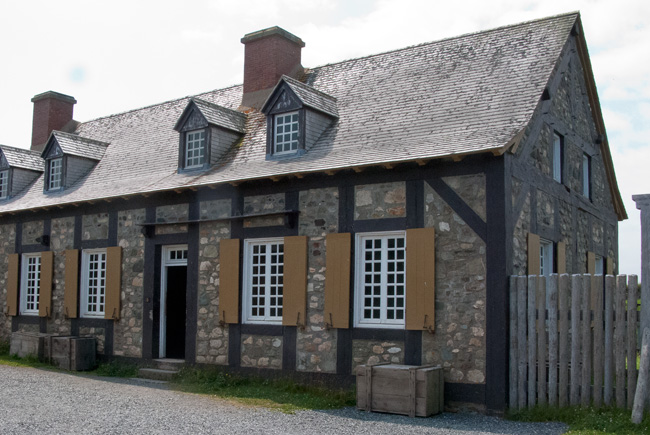
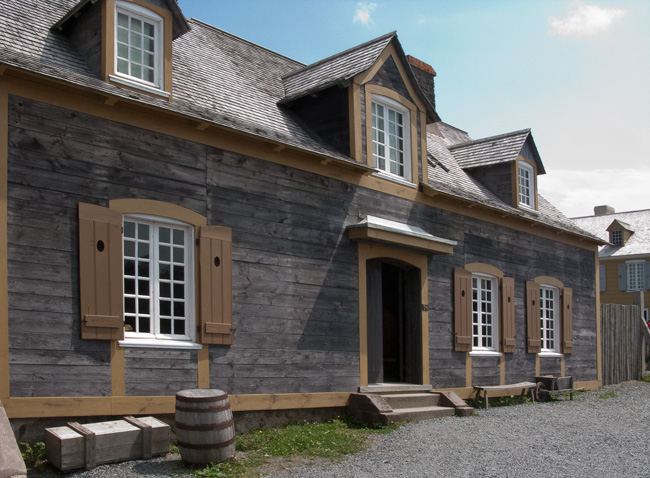
Our three hours were soon up and, while we could have spent a whole day here, we did walk away with a good perspective of the Fortess of Louisburg, an appreciation of its historic importance, and the amount of effort that was expended in its partial restoration; maybe another day ...
Back to the boat just as a big storm hit! As soon as it came it was gone and we got the cars back in one piece, albeit with nearly 600 miles on them ($$$$$).
Another big boat arrived today while we were returning our rental cars, an 85' Berger Yacht, "Victory."
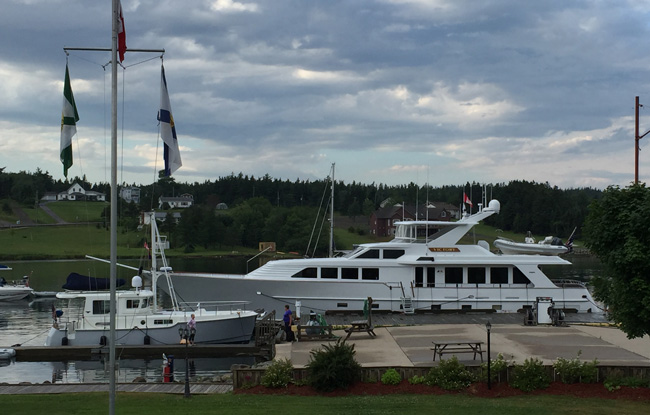
"Wings" a Little Dwarfed by "Victory"
Today was Bob's birthday and Jan had been busy cooking a birthday dinner for the crews of all four boats which we enjoyed in the marina clubhouse.

Barb, Bob, Jan, Stephen, Fran, Judy, Dave and Lee

Happy Birthday Bob!!
May 16 - 22 |
May 23 - 29 |
May 30 - Jun 5 |
Jun 6 - 12 |
Jun 13 - 19 |
Jun 20 - 26 |
Jun 27 - Jul 3 |
Jul 4 - 10 |
Jul 11 -17 |
Jul 18 - 24 |
Jul 25 - 31 |
Aug 1 - 7 |
Aug 8 - 14 |
Aug 15 -21 |
Aug 22 - 28 |
Aug 29 - Sep 4 |
Sep 5 - 11 |
Sep 12 - 18 |
Sep 19 - 25 |
